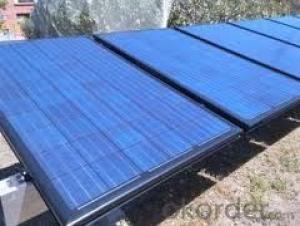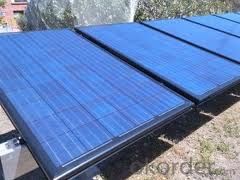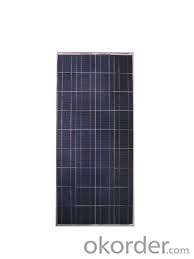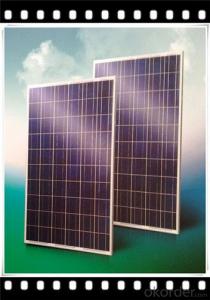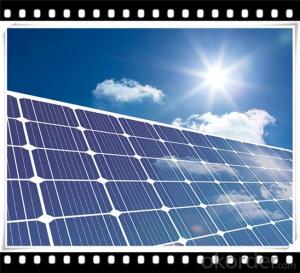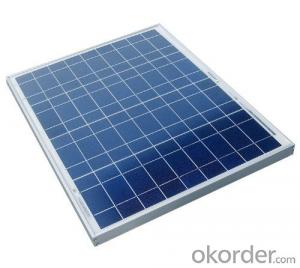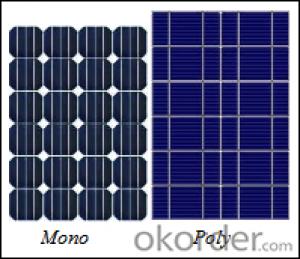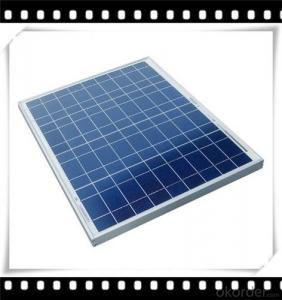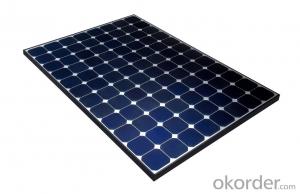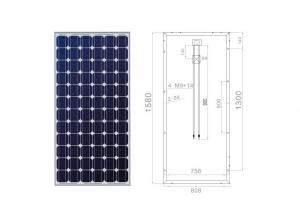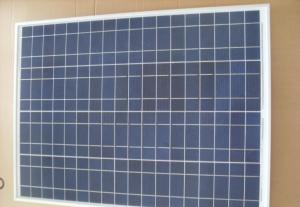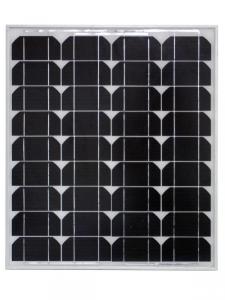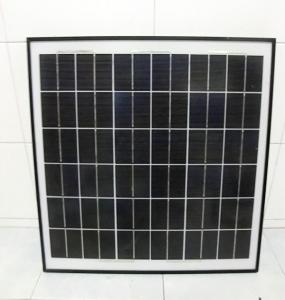75W Pole Mounted Mini Poly Solar Panel CNBM
- Loading Port:
- Qingdao
- Payment Terms:
- TT OR LC
- Min Order Qty:
- 10 set
- Supply Capability:
- 300000 set/month
OKorder Service Pledge
OKorder Financial Service
You Might Also Like
Polycrystalline Solar Modules
CNBM offers a range of small, medium and large polycrystalline solar modules, designed for a range of requirements.
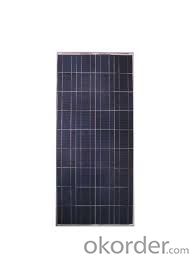
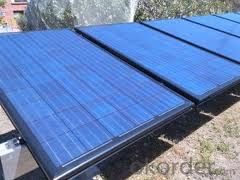
Specifications:
Toleranc | +/-3% |
Cell | Polycrystalline silicon solar cells (156 x 156mm) |
N0. of Cells | 60 (10 x 6) |
Dimension of Modules (mm) | 1650 x 990 x 40 |
Weight (kg) | 25.5 |
Limits:
Operating Temperature | -40~+85? |
Storage Temperature | -40~+85? |
Maximum System Voltage | 1000 VDC max. |
Hail Impact | Diameter of 28mm with impact speed |
Temperature and Coefficients:
NOCT | 48C+/-2? |
Voltage temperature coefficient (%/K) | -0.35 |
Current temperature coefficient (%/K) | 0.05 |
Power temperature coefficient (%/K) | -0.45 |
Characteristics:
Model: | SGM-200P | SGM-210P | SGM-220P |
Max-power voltage Vmp (V) | 29.2 | 29.4 | 29.41 |
Max-power current Imp (A) | 6.85 | 7.14 | 7.48 |
Open-circuit voltage Voc (V) | 36.5 | 36.69 | 36.9 |
Short-Circuit Current Isc (A) | 7.28 | 7.6 | 7.93 |
Max-power Pm(W) | 200 | 210 | 220 |
Model: | SGM-230P |
Max-power voltage Vmp (V) | 29.8 |
Max-power current Imp (A) | 7.72 |
Open-circuit voltage Voc (V) | 37.31 |
Short-Circuit Current Isc (A) | 8.19 |
Max-power Pm(W) | 230 |
STC: Irradiance 1000W/m2, module temperature 25?, AM-=1.5
Poly Crystalline Solar Panels Specifications Range
Maximum Power (Pm) | Dimension | Weight | Operating Voltage (Vmp) | Operating Current (Imp) | Open Circuit Voltage (Voc) | Short Circuit Current (Isc) |
0.45W | 140x80x10mm | 0.08kg | 3.3V | 150mA | 4.6V | 160mA |
1.0W | 162x140x10mm | 0.16kg | 7.5V | 150mA | 10.3V | 160mA |
4.5W | 269x251x23mm | 0.8kg | 16.5V | 0.27A | 20.5V | 0.3A |
10W | 420.1×268.9×22.6mm | 1.92kg | 17.5V | 0.58A | 20.5V | 0.6A |
20W | 425x502x50mm | 3.0kg | 16.8V | 1.19A | 21.0V | 1.29A |
30W | 593x502x22.6mm | 3.9kg | 16.8V | 1.78A | 21.0V | 1.94A |
40W | 655x537x50mm | 5.75kg | 17.3V | 2.31A | 22.1V | 2.54A |
50W | 839x537x50mm | 6.0kg | 17.5V | 2.9A | 21.8V | 3.17A |
65W | 1111x502x50mm | 7.2kg | 17.6V | 3.69A | 22.1V | 3.99A |
80W | 1204x537x50mm | 7.7kg | 17.6V | 4.55A | 22.1V | 4.8A |
- Q: How will i construct solar panel?
- For powering a something that works on DC, like a gate opener, Elaine is right, and in some cases only ONE bigger cell is sufficient due to battery storage; however if the appliance is 20v AC, then an inverter is needed also. MOST of Elaine's answer is good, but a few corrections are needed: Plywood - use EXTERIOR grade only, and even then it can warp; chipboard or waferboard is preferable as it does NOT warp, BUT is not available most places in 3/8, /2 nominal, (5/32) is usually the thinnest available, and it is heavier than plywood. DO NOT use particle board. Superglue - NO, it dries too fast to be useful, in most cases. Wires - For a single cell OK, but for larger panels the best wire is tabbing wire, (which is flat,) which is available from all commercial solar cell dealers. Be very careful soldering this to the cells, as unless you buy the expensive flexible cells, they are easily damaged; I suggest also getting flux pens with liquid flux. Diode - Necessary, but needs to be large enough to handle voltage and current. Usually 25v and 5-30 amps,, one per panel. Plexiglas - OK, but NOT as long lasting as glass; best glass is the special solar glass which is designed to pass almost all of the proper light frequencies, but IS expensive, and usually needs to be specially ordered since most glass stores do not stock it. Double panes work well with the outer pane glass and the inner plexiglas, (to protect the cell if glass broken,) IF where might get damage, such as 'ground' mounting. AND Frame kits are available for larger panels, but IF you make your own, a good table router is a great advantage. Inverter - IF used for 20v AC appliances you MUST have an inverter capable of handling the load, and the best ones are modified sine, or true sine, wave types, and even the best are less than 50% efficient. Note that they will last longer if NOT used at more than 2/3 capacity.
- Q: Ok so i can have a problem i have two 5 watt 2 volt solar panels a 2 volt battery and a 400 watt ac 2 volt dc inverter i believe im only getting 5 watts from from my solar panels thats the equivalent of one is there any way i could get full voltage from my solar panels without theoretically burning my wallet.. please help
- I think you need to take some basic courses on electricity. Usually, 8 volt solar panels are required to charge 2 volt batteries. The voltages of photovoltaic cells are set by the material they are made of, only current changes. If you hook up a 2 V solar panel to a 2 V battery, no current will flow, nothing would get charged. You would need some elaborate DC to DC voltage converters to charge a 2 V battery from 2 V solar panels. Solar panels can be connected in parallel or in series, as you've made the mistake of buying 2 V solar panel, you would have to wire them in series and have a charge controller that could limit the voltage of the charge. Did it ever occur to you that two 5 watt solar panels would not be able to provide the power needed by a 400 watt inverter? You're just running off your battery with your set up. Solar power is expensive power, you can not have solar without burning a hole in your wallet.
- Q: i have a calculator with a solar panel what could i power with it? like could i hook it up to a psp even though it will take forever to charge? and how would i do this?
- take a look at the back of the psp, most rechargeable things have technical specifications for what kind of charger to use, like the voltage, the amps, and the wiring
- Q: our school spends around $0,000 dollars on energy.we want to know how much money would installing solar panels on the roof save our school.
- even although photograph voltaic panels cost quite some funds up front and don't furnish a hundred% performance, over the existence of the device, a photo voltaic panel array can shop maximum folk funds. producers furnish 25 365 days production guarantee on panels and panels will often proceed to supply after the guaranty has expired. whilst a device is designed to supply 'internet metering' truly producing as a lot power a house makes use of it (the two by way of batteries or pushing it back on the grid the payback on the cost of the panels would be measured by way of dividing the device cost by way of the month-to-month power expenses. With the passage of a 30% federal tax credit on qualified platforms and assorted state classes, platforms will payback often in under a decade consistent with utilization factors and climate.
- Q: Can solar panels be used in areas with high levels of volcanic activity?
- Yes, solar panels can be used in areas with high levels of volcanic activity. While volcanic activity may pose certain challenges such as ash emissions or occasional cloud cover, solar panels can still generate electricity during periods of low activity. Additionally, solar panels can be designed and installed to withstand harsh environmental conditions, including volcanic ash deposition, ensuring their long-term functionality.
- Q: please help me
- Photovoltaic cells work because of the photoelectric effect. However, a solar panel can actually be using several different technologies that have the same common effect of generating electricity when the sun shines on them.
- Q: I really want a projector but i hear they use a lot of energy because of the lamp. I want a good one to watch movies and play games on. but i don't want one that is gonna kill the lighting bill.is there like a solar panel or something i could use for it. PLZ HELP.
- Do understand, that a solar panel is slow to pay for itself. Let's say your electric bill was $200 a month ($2400 a year). A solar system would cost perhaps $24,000 so you would actually have paid your first 0 years of electricity in advance when installing the panels. After that 0 years, you start to be ahead financially. It can still be a good idea, but it may not be the quick and cheap solution you were looking for.
- Q: Are there solar panel systems that I can plug directly into my house to help reduce my electricity bill? If so, are they very expensive? Any help would be greatly appreciated!
- As per the question, the answer is no. Solar panels are available, they are expensive, they can reduce your energy bill, you can get up to 30% of the expense back from your taxes, but they must be installed by a qualified electrician or solar panel installer to work properly.
- Q: Actually I want to convert my home electricity on Solar Panel to cut down electricity costI have 2 AC's, a refrigerator, 3 Television, 2 Computers, 4 Fans etc
- good okorder lots of good ideas there
- Q: why don't we take a cue from mother nature and make our soar panels like trees? thousands of leaves or needle (like a pine tree) instead of one big flat panel? I mean it seems to work pretty good for all the plants i see why would it not work for us. It would be aesthetically pleasing and with the right engineering wouldn't it make them not have to worry about tracking the sun? i already have some ideas about the process of making them just no available labratory.
- Because we and the trees are trying to solve a different problem. We want electricity, a tree wants light (and some heat) for photosynthesis. In getting the electricity we use Silicon for solar panels. (Sometimes Gallium Arsenide). And we exploit the same thing in Silicon that allows them to be computer chips. The fact that they conduct differently when voltage is applied. But for a solar panel that is done essentially in reverse. We GET a voltage difference (electricity) from shoving energy through it. Look up junction bias on google or yahoo for explanation. But the DESIGN problem is: You have to couple these panels together the right way - according to their bias. You can't string them up willy nilly. There is a pattern. And when one breaks in this pattern. (I mean when the actual panel cracks, which they do easily as they are brittle). It can change the overall bias. This can make even be worse than if it was removed, it can actually fight against the working ones. The efficiency is there in arranging them like a tree, but the practicality of maintenance would be daunting.
Send your message to us
75W Pole Mounted Mini Poly Solar Panel CNBM
- Loading Port:
- Qingdao
- Payment Terms:
- TT OR LC
- Min Order Qty:
- 10 set
- Supply Capability:
- 300000 set/month
OKorder Service Pledge
OKorder Financial Service
Similar products
Hot products
Hot Searches
Related keywords
